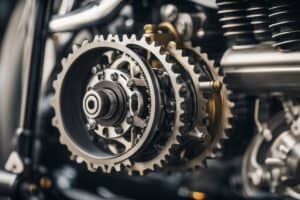If you own a motorcycle, you may have experienced the frustration of seeing an error code appear on your dashboard. One of the most common error codes is P2000, which indicates that the Nitrogen Oxide (NOx) Trap Efficiency is Below Threshold. This error code can be caused by a variety of issues, ranging from a faulty sensor to a damaged catalytic converter.
When your motorcycle’s engine is running, it produces harmful emissions such as nitrogen oxides. The NOx trap is a component in your motorcycle’s exhaust system that is designed to reduce these emissions. If the efficiency of the NOx trap falls below a certain threshold, it can trigger the P2000 error code. This can cause your motorcycle to fail emissions tests and may even result in a loss of power or reduced fuel efficiency.
Understanding Error Code P2000
Definition and Significance
If you own a motorcycle, you may have come across the error code P2000 at some point. This code refers to an issue with the nitrogen oxide (NOx) trap efficiency, which is part of the motorcycle’s emissions control system. The NOx trap is responsible for reducing the amount of harmful pollutants that are released into the environment.
When the NOx trap efficiency falls below a certain threshold, it triggers the P2000 error code. This means that your motorcycle is not meeting the emissions standards set by the Environmental Protection Agency (EPA) and may be releasing harmful pollutants into the air.
Causes of Error P2000
There are several reasons why your motorcycle may be triggering the P2000 error code. One common cause is a malfunctioning NOx sensor, which is responsible for monitoring the efficiency of the NOx trap. If the sensor is not working properly, it may send incorrect data to the engine control module (ECM), causing the P2000 code to appear.
Another possible cause is a clogged or damaged NOx trap. Over time, the trap can become filled with soot and other pollutants, reducing its efficiency. If the trap is damaged, it may not be able to filter out pollutants effectively, causing the P2000 code to appear.
Other potential causes of the P2000 error code include faulty wiring, a malfunctioning ECM, or a problem with the fuel system. If you are unsure of the cause of the error code, it is best to take your motorcycle to a certified mechanic for diagnosis and repair.
In conclusion, understanding the P2000 error code is important for maintaining the health of your motorcycle and the environment. By addressing the underlying causes of the code, you can ensure that your motorcycle is running efficiently and meeting emissions standards.
Diagnosing the Issue
Diagnostic Tools Required
To diagnose the Motorcycle Error Code P2000, you will need the following diagnostic tools:
- OBD-II scanner
- Multimeter
- Nitrogen Oxide (NOx) sensor tester
- Smoke tester
Step-by-Step Diagnosis Procedure
-
Connect the OBD-II scanner to the motorcycle’s diagnostic port and retrieve the error code P2000. This code indicates that the Nitrogen Oxide Trap Efficiency is below the threshold.
-
Check the NOx sensor’s wiring and connections using a multimeter. Ensure that the sensor is receiving power and ground.
-
Test the NOx sensor using a NOx sensor tester. This will help you determine if the sensor is faulty or not.
-
Check for any exhaust leaks or damages to the catalytic converter. A smoke tester can help you locate any leaks in the system.
-
If there are no exhaust leaks or damages, check the NOx trap’s efficiency using a NOx sensor tester. If the efficiency is below the threshold, the NOx trap may need to be replaced.
-
After replacing the NOx trap, clear the error code and test the motorcycle again to ensure that the issue has been resolved.
By following this step-by-step diagnosis procedure, you can accurately diagnose and fix the Motorcycle Error Code P2000.
What are the potential consequences of not addressing Motorcycle Error Code P0441?
Ignoring motorcycle error code P0441 can lead to potentially serious consequences for your vehicle. Failing to address this issue could result in decreased fuel efficiency, engine misfires, and even damage to the catalytic converter. It’s crucial to address any error codes to ensure optimal performance and safety on the road.
Nitrogen Oxide Trap Function
Component Overview
The Nitrogen Oxide (NOx) trap is an emission control device that is designed to reduce the amount of NOx emissions from the exhaust of a motorcycle. It is a part of the exhaust system and is usually located downstream of the engine and the catalytic converter.
The NOx trap is composed of two parts: the oxidation catalyst and the NOx storage and reduction catalyst. The oxidation catalyst is responsible for converting the hydrocarbons and carbon monoxide in the exhaust into carbon dioxide and water vapor. The NOx storage and reduction catalyst, on the other hand, is designed to store and reduce the amount of NOx in the exhaust.
Operation Principle
The NOx trap works by trapping the NOx emissions in the exhaust and storing them in the NOx storage and reduction catalyst. Once the catalyst is saturated with NOx, the engine control module (ECM) will initiate a regeneration cycle to burn off the stored NOx. During this process, the NOx is reduced to nitrogen and oxygen, which are harmless gases.
However, if the NOx trap efficiency falls below a certain threshold, the ECM will trigger a fault code, usually P2000, indicating that the NOx trap is not working properly. This can be caused by a variety of factors, such as a malfunctioning oxygen sensor, a clogged air filter, or a damaged NOx storage and reduction catalyst.
In conclusion, the NOx trap is an essential component of the motorcycle’s emission control system, designed to reduce the amount of harmful NOx emissions. Understanding its function and operation principle can help you identify and troubleshoot any issues with your motorcycle’s exhaust system.
Troubleshooting and Solutions
Common Fixes
If you encounter the P2000 error code on your motorcycle, there are a few common fixes you can try before taking it to a mechanic. Here are some of the things you can do:
- Check the oxygen sensor: The oxygen sensor is responsible for measuring the amount of oxygen in the exhaust. If it’s faulty or dirty, it can cause the P2000 error code. Check the sensor and clean or replace it if necessary.
- Check the catalytic converter: The catalytic converter is responsible for converting harmful gases into less harmful ones. If it’s clogged or damaged, it can cause the P2000 error code. Check the converter and replace it if necessary.
- Check the exhaust system: The exhaust system includes the muffler, pipes, and other components. If there are leaks or damage, it can cause the P2000 error code. Check the system and repair or replace any damaged parts.
Replacement Parts
If the common fixes don’t work, you may need to replace some parts. Here are some of the parts that may need to be replaced:
- Nitrogen oxide (NOx) sensor: The NOx sensor measures the amount of NOx in the exhaust. If it’s faulty or dirty, it can cause the P2000 error code. Replace the sensor if necessary.
- Nitrogen oxide trap: The nitrogen oxide trap is responsible for reducing the amount of NOx in the exhaust. If it’s not working properly, it can cause the P2000 error code. Replace the trap if necessary.
- Exhaust system: If the exhaust system is damaged beyond repair, you may need to replace it entirely. This includes the muffler, pipes, and other components.
By trying these common fixes and replacing any faulty parts, you can resolve the P2000 error code on your motorcycle and get back to riding with confidence.
Preventative Measures
If you want to avoid the Motorcycle Error Code P2000, there are a few preventative measures you can take. Regular maintenance and performance monitoring can help to prevent this error code from appearing.
Regular Maintenance Tips
To prevent the P2000 error code, you should regularly maintain your motorcycle. Here are some tips to help you keep your motorcycle in good condition:
- Change the oil and filter regularly to keep the engine running smoothly.
- Check the air filter and replace it if necessary to ensure proper air flow.
- Keep the tires inflated to the recommended pressure to prevent unnecessary wear and tear.
- Check the brakes and replace the pads if necessary to ensure proper stopping power.
- Keep the chain lubricated to prevent unnecessary wear and tear.
Performance Monitoring
Performance monitoring is another way to prevent the P2000 error code. Here are some tips to help you monitor your motorcycle’s performance:
- Use a diagnostic tool to monitor your motorcycle’s performance and detect any potential issues before they become major problems.
- Keep an eye on your motorcycle’s fuel consumption. If you notice that your motorcycle is using more fuel than usual, it could be a sign that there is an issue with the nitrogen oxide trap efficiency.
- Pay attention to any unusual sounds or vibrations coming from your motorcycle. These could be signs of a potential issue that needs to be addressed.
By following these preventative measures, you can help to prevent the Motorcycle Error Code P2000 from appearing and keep your motorcycle running smoothly.
As an Amazon Associate we earn from qualifying purchases.















